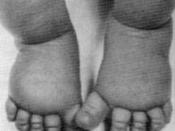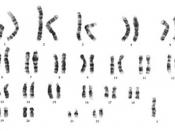Turner Syndrome was first described by Dr. Henry Turner in 1938. He noticed some common physical features in some of his female patients. It wasn't until 1960 that a chromosomal abnormality was found in people with the physical features that Dr. Turner described. Turner Syndrome only affects females because a lone Y chromosome cannot survive but a single X chromosome can. Females with Turner Syndrome either have only one X chromosome or one of the X chromosomes is piecing a piece or is misshapen.
Females with Turner Syndrome exhibit many symptoms. Some are: short stature, webbed neck, horseshoe kidney, cataracts, arthritis, high blood pressure, low hairline, scoliosis, soft nails, abnormal eye features, absence of secondary sexual characteristics such as breasts and pubic hair, infertility, a simian crease, absence of menstruation, widely spaced nipples, and obesity. Not all people that have Turner Syndrome will exhibit all of the symptoms. Some people exhibit many but others may only exhibit a few.
Occasionally a girl with Turner Syndrome will have mosaicism, which means that not all of her cells are missing an X chromosome. When mosaicism occurs, the woman may exhibit only a few of the symptoms.
Turner Syndrome occurs in about 1 in 3,000 live births. A karyotype is required to absolutely diagnose Turner Syndrome. An amniocentesis can prenatally diagnose Turner Syndrome, as well. Only 5% of Turner Syndrome fetuses survive to full term, 95% are spontaneously miscarried. Turner Syndrome is genetic but very rarely hereditary. A woman with Turner Syndrome has a low probability of being fertile but when one does become pregnant and passes on her normal X chromosome to her offspring no continuation is expected.
Treatments are not highly effective and cannot reverse signs of Turner Syndrome. Estrogen therapy can be started around ages 12 or...



Job well done
I believe that the very simplistic way in which you chose to write your report was very helpful to the commoner reader and helped them easily grasp the idea of Turner Syndrome.
8 out of 8 people found this comment useful.